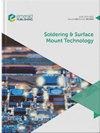优化铈添加量对SAC305显微组织和力学性能的影响
IF 1.8
4区 材料科学
Q3 ENGINEERING, ELECTRICAL & ELECTRONIC
引用次数: 2
摘要
目的分析添加铈对锡银铜(SAC)合金组织和力学性能的影响。焊点的机械性能和精细的微观结构对电子器件的可靠性和性能至关重要。SAC305合金是用作无铅焊料的潜在选择,因为与传统的锡铅焊料合金相比,SAC305合金具有良好的性能。然而,SAC305合金微观结构中大块金属间化合物(IMCs)的存在影响了其整体性能。因此,铈的加入抑制了IMCs的生长并细化了微观结构,从而提高了力学性能。设计/方法/方法SAC305合金掺杂了不同组成的xCerium(x=0.15、0.35、0.55、0.75、0.95)重量%。粉末形式的纯元素在氩气存在下定期搅拌熔化,以确保均匀熔化的合金。然后将熔融合金倒入预热模具中以获得拉伸试样。使用10的固定应变速率测定屈服强度和通用拉伸强度 毫米/分钟或0.1667 毫米s^(−1)。IMCs使用X射线衍射进行鉴定,而元素相组成和微观结构演变分别通过电子色散光谱和扫描电子显微镜进行检查。发现添加0.15%的铈可以改善微观结构和机械性能。拉伸试验还表明,SAC305-0.15%的铈比其他成分表现出更大的应力承载能力。0.75%的铈掺杂合金由于断裂位错区的减少而表现出一定的改善,但微观结构的细化和IMCs的排列与0.15%的铈不同。鉴定了Cu_6Sn_5、Ag_3Sn、CeSn_3和ß-Sn的不同相。因此,较低浓度的铈的添加和Ce-Sn IMCs的存在改善了合金的晶界结构,导致合金微观结构的细化,以及机械性能的提高。独创性/价值对SAC305xCerium合金的不同成分进行了微观结构表征和力学性能评估。最后,选择了一种用于电子器件焊点的优化铈组分。本文章由计算机程序翻译,如有差异,请以英文原文为准。
Optimized cerium addition for microstructure and mechanical properties of SAC305
Purpose
This paper aims to analyze the effect of cerium addition on the microstructure and the mechanical properties of Tin-Silver-Copper (SAC) alloy. The mechanical properties and refined microstructure of a solder joint are vital for the reliability and performance of electronics. SAC305 alloys are potential choices to use as lead-free solders because of their good properties as compared to the conventional Tin-Lead solder alloys. However, the presence of bulk intermetallic compounds (IMCs) in the microstructure of SAC305 alloys affects their overall performance. Therefore, addition of cerium restrains the growth of IMCs and refines the microstructure, hence improving the mechanical performance.
Design/methodology/approach
SAC305 alloy is doped with various composition of xCerium (x = 0.15, 0.35, 0.55, 0.75, 0.95) % by weight. Pure elements in powdered form were melted in the presence of argon with periodic stirring to ensure a uniform melted alloy. The molten alloy is then poured into a pre-heated die to obtain a tensile specimen. The yield strength and universal tensile strength were determined using a fixed strain rate of 10 mm per minute or 0.1667 mm s^(−1). The IMCs are identified using X-ray diffraction, whereas the elemental phase composition and microstructure evolution are, respectively, examined by using electron dispersive spectroscopy and scanning electron microscopy.
Findings
Improvement in the microstructure and mechanical properties is observed with 0.15% of cerium additions. The tensile test also showed that SAC305-0.15% cerium exhibits more stress-bearing capacity than other compositions. The 0.75% cerium doped alloy indicated some improvement because of a decrease in fracture dislocation regions, but microstructure refinement and the arrangement of IMCs are not those of 0.15% Ce. Different phases of Cu_6 Sn_5, Ag_3 Sn and CeSn_3 and ß-Sn are identified. Therefore, the addition of cerium in lower concentrations and presence of Ce-Sn IMCs improved the grain boundary structure and resulted refinement in the microstructure of the alloy, as well as an enhancement in the mechanical properties.
Originality/value
Characterization of microstructure and evaluation of mechanical properties are carried out to investigate the different composition of SAC305-xCerium alloys. Finally, an optimized cerium composition is selected for solder joint in electronics.
求助全文
通过发布文献求助,成功后即可免费获取论文全文。
去求助
来源期刊

Soldering & Surface Mount Technology
工程技术-材料科学:综合
CiteScore
4.10
自引率
15.00%
发文量
30
审稿时长
>12 weeks
期刊介绍:
Soldering & Surface Mount Technology seeks to make an important contribution to the advancement of research and application within the technical body of knowledge and expertise in this vital area. Soldering & Surface Mount Technology compliments its sister publications; Circuit World and Microelectronics International.
The journal covers all aspects of SMT from alloys, pastes and fluxes, to reliability and environmental effects, and is currently providing an important dissemination route for new knowledge on lead-free solders and processes. The journal comprises a multidisciplinary study of the key materials and technologies used to assemble state of the art functional electronic devices. The key focus is on assembling devices and interconnecting components via soldering, whilst also embracing a broad range of related approaches.
 求助内容:
求助内容: 应助结果提醒方式:
应助结果提醒方式:


